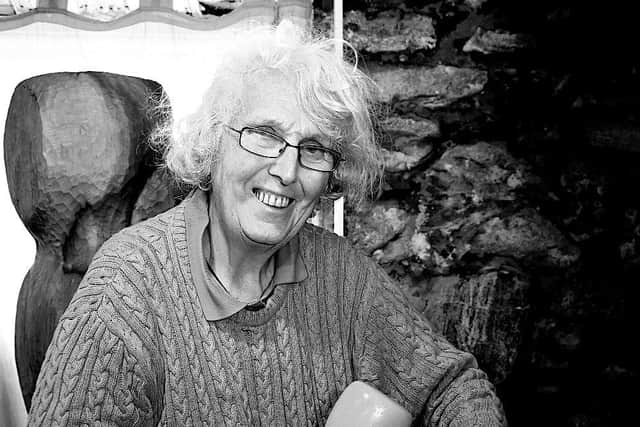Scotsman Obituaries: Dorothy Dick, Scot who swapped engineering for sculpture
She should undoubtedly have gone straight from the classroom to art school but her unwillingness to teach and worries about earning a living focused Dorothy Dick’s career on a more practical path.
Dorothy, whose artistic talent was evident from a young age, also excelled in Maths and science, skills which led to her becoming an engineer on such diverse projects as the performance of missiles, the operation of a nuclear power station and the design of oil platforms.
Advertisement
Hide AdAdvertisement
Hide AdBut always in the background was her love of art and the pursuit of a long-held desire to devote herself full-time to her key interest – sculpture.


She finally achieved that ambition in her fifties, moving to the rugged beauty of Sutherland where she established a studio with adjacent gallery to exhibit her work – her pieces are held in private collections across the UK, Holland, Switzerland and the USA – and that of other artists.
Born in Glasgow, Dorothy was an only child who spent hours making balsa wood models of ships, planes and trains.
At Albert Road Academy her art mistress recognised her artistic talent but, despite the school’s belief she should go to art school, the young Dorothy went to study Maths and Physics at Glasgow University.
However, she also began attending evening classes at Glasgow School of Art, starting with ceramics, a discipline attached to the sculpture department.
After graduating she moved to Luton to work with English Electric, simulating, on analogue computer, the performance of missiles.
Dorothy also attended ceramics evening classes at St Albans School of Art.
Returning north in 1960, she joined the South of Scotland Electricity Board where her role included computer modelling of the operation of Ayrshire’s Hunterston B nuclear power station.
Advertisement
Hide AdAdvertisement
Hide AdShe also trained part-time in sculpture at the Glasgow School of Art under the Austrian sculptor Paul Zunterstein in the department of Estonian sculptor Benno Shotz and rented a farm cottage in the Campsies which she used as a studio at weekends, and began exhibiting.
Over the years she exhibited in Glasgow, Edinburgh, including at the Royal Scottish Academy, and London.
Dorothy, whose work was figurative, carved in the traditional way with mallet and gouges, either in wood or stone, or modelled in clay and cast, sometimes scaling up pieces for outdoor sites.
Sculptor Henry Moore’s work was a major early influence but she also referenced African sculpture in her masks and carved heads.
By 1973 she was working on computer programming at Babcock & Wilcox. Then aged 40, she had given up a full-time engineering career to work part-time in the company’s research centre and sculpt part-time.
In 1978 Dorothy moved to the British National Oil Corporation (later Britoil) where she was involved in the conceptual design of oil production platforms. She also had her own studio in Glasgow’s Newlands and, at the age of 55, retired from engineering completely to become a full-time sculptor.
Her mother was originally from Sutherland and after inheriting a property in Scourie, Dorothy developed it to create another studio and a gallery.
It opened in 1989 showing her work, plus prints and paintings by Scottish-based artists, during the summer months.
Advertisement
Hide AdAdvertisement
Hide AdDorothy had collected art for many years, including works by James Morrison, Elizabeth Blackadder, Philip Reeves and Margot Sandeman, and had a keen interest in Danish design.
She also had a vast personal collection of 2,000 books.
Around 2003 she sold her Glasgow home and moved her entire studio to Scourie where she owned three properties side by side, plus a bothy up the hill where she could be assured of isolation and the peace to read or draw.
Happy in her own company, she had the hillside by the bothy planted with native trees which guaranteed solitude and appealed to the more reclusive side of Dorothy’s nature.
Having previously travelled widely in Europe to study the arts, particularly in Italy and Greece, she now ceased to travel and preferred the local beach for reflection and solace.
Latterly, before dementia took hold, Dorothy could be seen driving the pick-up truck she used for transporting her work and materials – although she also hankered after a quad bike at one point – or taking her daily stroll to the village shop to collect her newspaper.
An avid Guardian reader, she was a staunch Labour Party member and a past president of the Royal Philosophical Society of Glasgow.
Having made Scourie her home, Dorothy, who never married, always hoped her sculpture would be her legacy to the village.
A couple of years ago a proposal was made to the Scourie Community Development Company, which aims to create a new visitor centre, to include within it the Dorothy Dick Collection of selected sculptures and Scottish art.
Obituaries
If you would like to submit an obituary (800-1000 words preferred, with jpeg image), or have a suggestion for a subject, contact [email protected]